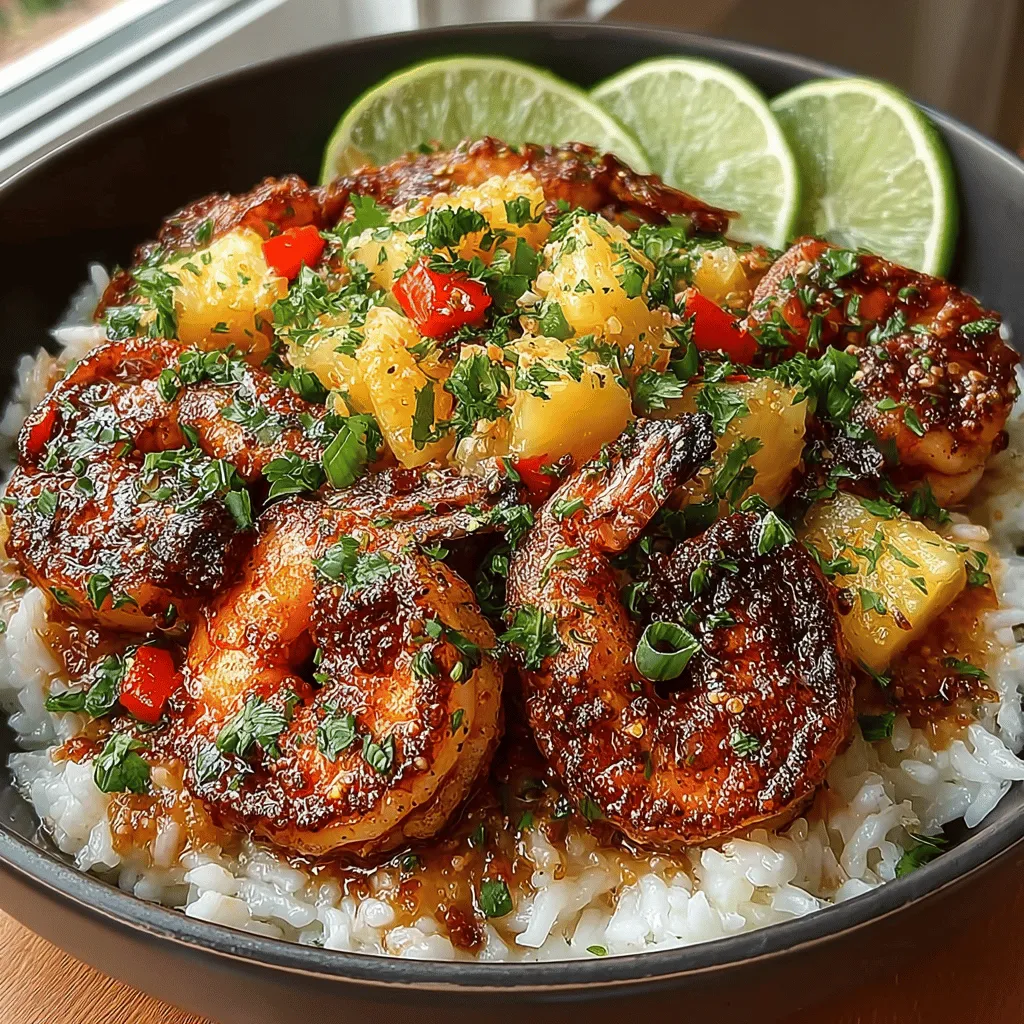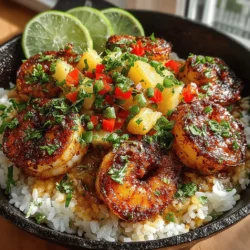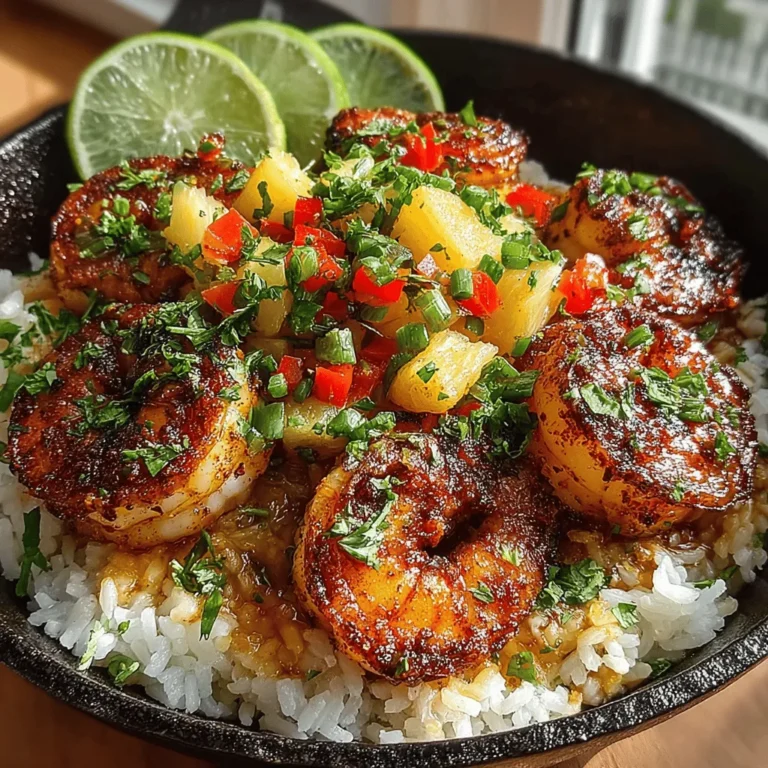Cajun Fiesta Shrimp with Tropical Rice: A Flavorful Culinary Journey
Cajun cuisine is a vibrant tapestry of flavors, colors, and traditions rooted in the rich cultural heritage of Southern Louisiana. Known for its bold spices and hearty ingredients, Cajun cooking embodies the essence of comfort food while celebrating its unique Creole influences. From the iconic jambalaya to mouthwatering gumbo, Cajun dishes are crafted with love, often bringing families and friends together around the dinner table. One fantastic representation of this culinary tradition is the enticing recipe for Cajun Fiesta Shrimp with Tropical Rice.
This dish beautifully marries the robust flavors of Cajun spices with the refreshing sweetness of tropical ingredients, resulting in a meal that is both exciting and satisfying. Picture succulent shrimp seasoned with a blend of spices, grilled to perfection, and served over a bed of fragrant rice infused with pineapple and coconut milk. The contrast of savory and sweet, along with the vibrant colors of the dish, makes it a feast for the senses. Perfect for family gatherings, summer barbecues, or anytime you want to impress your guests, Cajun Fiesta Shrimp with Tropical Rice is sure to be a crowd-pleaser.
Understanding Cajun Cuisine
At its core, Cajun cuisine is defined by its use of locally sourced ingredients and a distinctive cooking style that reflects the region’s agricultural roots. Originating from the French-speaking Acadian settlers who arrived in Louisiana, Cajun cooking emphasizes hearty meals that can feed a family, often made with whatever ingredients are on hand. The hallmark of Cajun food is its bold seasoning, primarily driven by a variety of spices such as paprika, cayenne pepper, garlic powder, and thyme, creating a depth of flavor that is unmistakably Cajun.
Key ingredients in Cajun dishes often include seafood, such as shrimp and crawfish, along with meats like chicken and sausage. Vegetables like onions, bell peppers, and celery—collectively known as the “holy trinity” of Cajun cooking—form the flavor base for many recipes. The cultural significance of Cajun food extends beyond mere sustenance; it represents a way of life, a connection to the land, and a celebration of community. Whether enjoyed at a family gathering or a lively festival, Cajun cuisine has the power to bring people together.
The Allure of Tropical Ingredients
Incorporating tropical flavors into Cajun cuisine adds an exciting twist that elevates traditional dishes to new heights. The use of fresh fruits and herbs can transform a meal, lending a bright, refreshing quality that complements the heat of Cajun spices. The sweetness of fruits like pineapple balances the savory elements of the dish, creating a harmonious blend of flavors that is both unique and satisfying.
In this recipe, pineapple and coconut milk play pivotal roles. Pineapple, with its juicy texture and tangy sweetness, not only enhances the flavor of the rice but also adds a delightful contrast to the spicy shrimp. Coconut milk, creamy and rich, infuses the rice with a subtle sweetness, creating a comforting base that perfectly complements the boldness of the Cajun seasoning. Together, these tropical ingredients help to transport your taste buds to a warm, sunny paradise, making this dish a perfect choice for summer dining.
Ingredients Breakdown
To prepare Cajun Fiesta Shrimp with Tropical Rice, you’ll need an array of ingredients that work together to create a symphony of flavors. Here’s a detailed list of what you will need:
For the Cajun Grilled Shrimp:
– Jumbo Shrimp: Opt for large or jumbo shrimp, ideally deveined and peeled, as they provide a satisfying texture and a meaty bite that holds up well to grilling.
– Cajun Seasoning: A blend of paprika, cayenne pepper, garlic powder, onion powder, and dried herbs. You can use store-bought seasoning or make your own for a personalized touch.
– Olive Oil: This helps to marinate the shrimp, adding moisture and preventing sticking during grilling.
– Lemon Juice: Freshly squeezed lemon juice brightens the dish and adds a zesty kick.
For the Pineapple Rice:
– Jasmine Rice: This fragrant rice variety is perfect for absorbing flavors and has a slightly sticky texture that pairs well with the tropical elements of the dish.
– Pineapple: Fresh pineapple is preferable for its sweetness and texture, but canned pineapple can work in a pinch. Chop it into small pieces to distribute evenly throughout the rice.
– Coconut Milk: Use full-fat coconut milk for a creamy, rich flavor that enhances the tropical aspect of the dish.
– Vegetables: Diced red bell pepper and sliced green onions add color, crunch, and additional flavor to the rice. They complement the sweetness of the pineapple and the heat of the shrimp.
Before diving into the cooking process, it’s crucial to prepare your ingredients meticulously. The shrimp should be marinated to allow the flavors to meld, and the rice should be cooked with attention to detail to ensure it turns out fluffy and infused with the delicious tropical elements.
Marinating the Shrimp
The first step in crafting this tantalizing dish is marinating the shrimp, which is essential for infusing them with flavor. Begin by placing the cleaned and deveined jumbo shrimp in a mixing bowl. Add a generous amount of Cajun seasoning, along with olive oil and freshly squeezed lemon juice. The oil aids in the distribution of spices, while the lemon juice adds a touch of acidity that brightens the overall flavor profile.
Gently toss the shrimp in the marinade until they are evenly coated. For the best results, allow the shrimp to marinate for at least 30 minutes, or up to two hours if time permits. This resting period not only enhances the taste but also ensures that the shrimp absorb the spices deeply, resulting in a more flavorful dish after grilling.
As you prepare the shrimp, this is an excellent time to begin cooking the jasmine rice. Rinse the rice under cold water until the water runs clear to remove excess starch. This step is crucial for achieving the desired fluffy texture. Cook the rice according to package instructions, using a combination of coconut milk and water to enhance the flavor. The aroma of the coconut milk as it simmers with the rice will transport you to a tropical paradise, setting the stage for the delicious meal ahead.
Stay tuned for the next part of the article, where we will delve deeper into the cooking techniques and final touches that will bring your Cajun Fiesta Shrimp with Tropical Rice to life!

Importance of Marinating Shrimp for Flavor Enhancement
Marinating shrimp is an essential step in elevating the flavor of this dish. Shrimp, while naturally delicious, benefits immensely from a well-balanced marinade that infuses taste and moisture, ensuring each bite is a burst of flavor. The Cajun spices, combined with lime juice and garlic, create a zesty profile that complements the sweetness of the pineapple and the savoriness of the rice.
Step-by-Step Process of Marinating the Shrimp
1. Prepare the Marinade: In a mixing bowl, combine 1/4 cup of olive oil, the juice of two limes, 3 minced garlic cloves, 1 tablespoon of Cajun seasoning, and a pinch of salt and pepper. Whisk until well blended.
2. Add the Shrimp: Place 1 pound of peeled and deveined shrimp into the bowl. Ensure all shrimp are coated evenly with the marinade.
3. Cover and Refrigerate: Cover the bowl with plastic wrap or transfer the shrimp to a resealable plastic bag. Allow it to marinate in the refrigerator for at least 30 minutes but no longer than 2 hours. This time frame allows the shrimp to absorb the flavors without becoming overly salty or mushy.
Tips on How Long to Marinate for the Best Results
For optimal flavor, aim for a marination time of 1 hour. This duration allows enough time for the shrimp to soak up the marinade while maintaining their firm texture. If you’re short on time, even a 15-minute marination will enhance the dish, but avoid marinating for more than 2 hours to prevent the shrimp from becoming over-seasoned and losing their natural sweetness.
Cooking the Pineapple Rice
The tropical rice is the perfect accompaniment to the Cajun shrimp, providing a sweet and savory balance that enhances the overall dish.
Step-by-Step Instructions for Preparing Jasmine Rice
1. Rinse the Rice: Start with 1 cup of jasmine rice. Place it in a fine-mesh strainer and rinse under cold water until the water runs clear. Rinsing removes excess starch, which helps prevent the rice from becoming gummy during cooking.
2. Cook the Rice: In a medium saucepan, combine the rinsed rice with 1 3/4 cups of water and a pinch of salt. Bring to a boil, then reduce the heat to low, cover, and simmer for about 15-18 minutes, or until the water is fully absorbed.
3. Fluff the Rice: Once the rice is cooked, remove it from heat and let it sit covered for an additional 5 minutes. Fluff with a fork to separate the grains.
Importance of Rinsing Rice and How It Affects Texture
Rinsing jasmine rice is crucial for achieving the right texture. By removing excess surface starch, you prevent the rice from clumping together and ensure a light, fluffy result. This step is particularly important in a dish like Cajun Fiesta Shrimp with Tropical Rice, where you want each grain to stand out and support the flavors of the shrimp and pineapple.
Incorporating Pineapple and Vegetables into Cooked Rice for Flavor Balance
To enhance the tropical aspect of the rice, add 1 cup of finely diced fresh pineapple, 1/2 cup of diced bell pepper (red or yellow for sweetness), and 1/4 cup of chopped green onions to the cooked rice. Stir gently to combine. The heat from the rice will slightly soften the pineapple and vegetables, allowing their flavors to meld beautifully while maintaining a fresh, vibrant taste.
Grilling the Shrimp
Grilling shrimp brings out their natural sweetness and adds a delightful smoky flavor. This method is quick and ensures that the shrimp remain juicy and tender.
Best Practices for Grilling Shrimp to Achieve Perfect Texture
1. Preheat the Grill: Ensure your grill is preheated to medium-high heat, around 400°F (200°C). A properly heated grill sears the shrimp immediately, locking in moisture and flavor.
2. Use Skewers: For easier handling, thread the marinated shrimp onto skewers. If using wooden skewers, soak them in water for at least 30 minutes beforehand to prevent burning.
3. Grill the Shrimp: Place the skewers on the grill and cook for 2-3 minutes on each side, or until they turn pink and opaque. Avoid overcooking, as shrimp can become rubbery if left on the grill too long.
Tips on Using Skewers and Avoiding Common Grilling Mistakes
– Space the Shrimp: When threading shrimp onto skewers, leave a little space between each piece to ensure even cooking.
– Don’t Flip Too Soon: Allow the shrimp to develop a nice sear before flipping them. If they stick to the grill, they may not be ready to turn.
– Check for Doneness: Shrimp cook quickly; watch for the color change and a firm texture. Remove them from the grill as soon as they are done to avoid overcooking.
Discussion on the Importance of Grilling Temperature and Timing
Grilling at the right temperature is essential for achieving that perfect caramelized exterior while ensuring the shrimp remain juicy inside. Medium-high heat allows for quick cooking, resulting in a satisfying texture. Keeping an eye on timing is equally important; remember, shrimp only need a few minutes on each side, so be prepared to remove them promptly once they’re cooked through.
Assembling the Dish
Once the shrimp are grilled and the rice is prepared, it’s time to assemble your beautiful dish.
Step-by-Step Guide on How to Plate the Dish Beautifully
1. Start with the Rice: Scoop a generous portion of the tropical rice onto the center of a plate, creating a small mound.
2. Add the Grilled Shrimp: Arrange the grilled shrimp skewers artfully on top of the rice, allowing the shrimp to cascade slightly over the sides for an inviting presentation.
3. Garnish: Sprinkle freshly chopped cilantro over the dish for a pop of color and added flavor. Squeeze fresh lime juice over the top to enhance the zestiness.
Suggestions for Garnishing with Cilantro and Lime for Added Freshness
Cilantro not only adds a vibrant green hue but also a fresh, herbaceous note that complements the Cajun spices. Lime wedges on the side provide an option for guests to add extra acidity, enhancing the overall flavor of the dish.
Ideas for Serving and Pairing with Beverages
Cajun Fiesta Shrimp with Tropical Rice pairs wonderfully with a variety of beverages. Consider serving it with a chilled glass of white wine, such as Sauvignon Blanc or a tropical cocktail like a mojito. For non-alcoholic options, a refreshing iced tea or sparkling water with lime would be delightful.
Nutritional Benefits of the Dish
This dish not only tantalizes the taste buds but also offers several health benefits.
Overview of the Health Benefits of Shrimp
Shrimp are low in calories yet high in protein, making them an excellent choice for a healthy diet. They are also a good source of essential nutrients, including selenium, vitamin B12, and iodine, which contribute to overall health and well-being.
Nutritional Value of the Ingredients Used in the Recipe
– Jasmine Rice: Provides carbohydrates for energy and is gluten-free.
– Pineapple: Packed with vitamin C and bromelain, which aids digestion and has anti-inflammatory properties.
– Vegetables: Bell peppers and green onions add vitamins, minerals, and fiber, promoting a balanced meal.
Balancing Flavors and Health in a Home-Cooked Meal
By incorporating fresh ingredients like shrimp and pineapple, along with wholesome jasmine rice and colorful veggies, this dish balances indulgence with nutrition. It allows you to enjoy a meal that is not only delicious but also supports a healthy lifestyle.
Conclusion
Cajun Fiesta Shrimp with Tropical Rice is a vibrant and flavorful dish that captures the essence of both Cajun and tropical cuisine. Its combination of zesty, marinated shrimp paired with sweet pineapple-infused rice creates a culinary experience that is both satisfying and enjoyable.
Preparing this dish at home is a simple yet rewarding endeavor, allowing you to explore the bold flavors of Cajun cooking while enjoying the freshness of tropical ingredients. We encourage you to try this recipe and dive deeper into the world of Cajun and tropical flavors. With each bite, you’ll discover the joy of cooking and the pleasure of sharing delicious meals with your loved ones.


